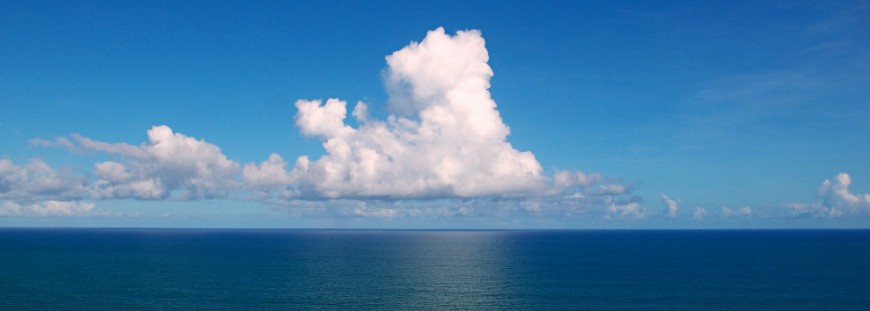Microfiber & other plastic debris threaten ocean wildlife. Photo by Tiago Fioreze, via Wikipedia.
As a part-time fishing guide, water is an essential element of my life. What happens to and in the water has a direct impact on the quality of the experience for my clients. As a board member of the American Fly Fishing Trade Association (AFFTA), I have a keen interest in how the industry looks at and addresses water issues, whether they are access or quality. As the deputy director of the Marine Fish Conservation Network where my focus is on marine issues, so I am tuned into the challenges we face with our oceans.
One subject that gets my attention in all three areas of my professional life is the issue of plastic pollution. The shop I guide for, Mossy Creek Fly Fishing, found an innovative solution to the use of disposable plastic containers for fishing flies. AFFTA quickly embraced this solution and now promotes it as an industry best practice. Packaging is the biggest part of the plastic pollution problem but not the only one. It was the small stuff that recently caught my attention.
One company that is at the forefront of environmental issues is Patagonia. They have been educating people about plastic pollution in our oceans for years. In June 2016, they turned their attention to microplastics in the waste stream. According to the post, What Do We Know About Tiny Plastic Fibers in the Ocean? in Patagonia’s Footprint Chronicles, the microfibers in synthetic clothes like fleece are shed during washing and are not captured by filter systems in treatment plants. The microfibers wind up in the ocean, on beaches, and in rivers and lakes. According to Patagonia:
While knowing there is a problem is a key first step, the important question is what each of us can do about it. Somedays the challenges we face seem daunting especially when seen through the twin lens of policy and politics. Daunting they may be, but there are things we as individuals can do to make a difference.
Last month in a follow-up post, An Update on Microfiber Pollution, Patagonia
shared what they have learned and where they are headed. “Over the past two years, the shedding of microfibers from Patagonia’s synthetic garments has taken on heightened urgency in how we consider our priorities moving forward. We’ve been working on several fronts…”
Here are the steps Patagonia suggests individuals can take.
- Keep Using It: Keeping our gear in use longer is something we can all do to reduce our personal impact on the planet. Buy only what you need, buy high quality and make it last. In Patagonia’s recent study with researchers at the University of California, Santa Barbara, a low-quality, generic-brand fleece shed significantly more over its life span than Patagonia’s high-quality products (brenmicroplastics.weebly.com).
- Wash Less Often & Invest in a Front-load Washer: Microfibers shed in the wash—so wash your gear only when it’s absolutely necessary (you’ll conserve water in the process). Even your most-used outerwear should only need a full wash occasionally. If it’s caked with dirt (and we hope it will be), consider using a rag or sponge to spot clean rather than putting it through a machine cycle. And consider your washing machine: Studies show synthetic jackets laundered in top-load washing machines shed more than five times as many microfibers as the same jacket in front-load washers.
- Fiber Filters Help: Putting your synthetic clothing into a filter bag before washing by hand or machine can significantly reduce the flow of microfibers into your drain. Starting in the coming weeks, you can buy (at cost) the easy-to-use Guppy Friend (guppyfriend.com) at Patagonia.com throughout the United States and Europe. Or install a permanent washing machine filter (requires some plumbing expertise), like Wexco’s Filtrol 160 (septicsafe.com/washing-machine-filter).
I admire the leadership Patagonia shows with their corporate ethic and willingness to recognize the impacts their products have, do the research on that impact and look for solutions not only in their manufacturing process but providing ways the end users can mitigate that impact. The least we can do as consumers is educate ourselves and act responsibly. The oceans and their inhabitants will thank us.



Pingback: Microfiber Pollution in our Oceans
Pingback: Microfiber Pollution | Middle River Dispatches
Thanks for writing about Microfiber water pollution. I found the part about the type of washer to be very interesting. What a difference the design of a product can make on the environment. The fashion industry has to start addressing this issue from within. For the past few years I have been working on an alternative to the polyester fabric used in the outdoor industry. After a few prototypes, I have a polyester free moisture wicking cotton twill that can compete with synthetic fibers in the market. We can offer the consumer the fabric they want without the harmful effects on the environment. We did this because even if you use a bag or coral ball to reduce microfiber pollution the best alternative is to reduce polyester overall and limit its use.
Stuart
Blue Zipper
http://www.bluezippercool.com